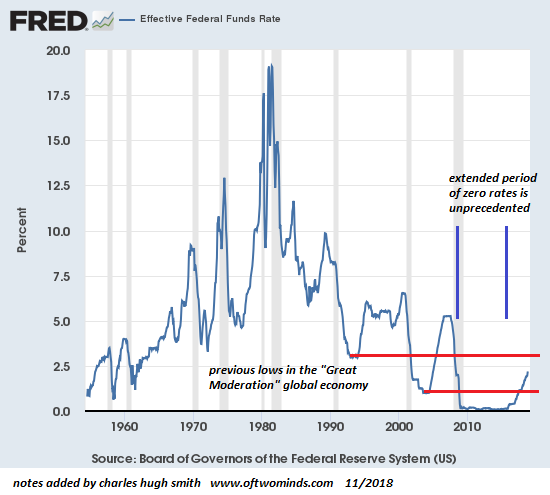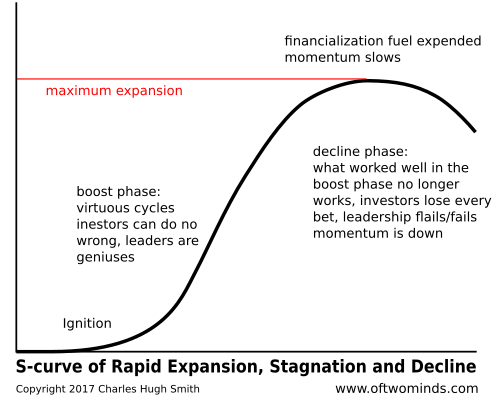2019 is shaping up as the year that no longer work all policies that worked in the past. As we all know, the global financial crisis / recession of 2008-09 was stopped due to coordinated policies of major central banks, which reduced interest rates to almost zero, bought trillion in bonds and doubtful assets and backed by mortgages. securities and credit lines issued unlimited insolvent banks, ie unlimited liquidity.
Central governments could do so took a measure of borrowing / spending to boost demand in their economies and implemented other policies designed to advance the demand , ie, encourage households to buy today what they had planned to buy in the future.
This great flood of credit and liquidity at low cost encouraged corporations to borrow money and use it to buy back its shares, increasing earnings per share and making stocks rise for a decade.
The success of these policies has created a dangerous confidence that operate in the next global recession, currently scheduled for 2019. But political follow the curve in S expansion, maturity and decline, like the rest of human endeavor: the next time around, these policies will do more than what has failed.
The global economy has changed. The lawsuit has been brought forward for a decade, effectively draining the whole future demand. Purchases of unprecedented assets, low interest rates and unlimited liquidity have inflated huge credit bubbles / assets worldwide, the so - called " bubble all", as most asset classes are now correlated with central bank policies rather than with the fundamentals of the real economy. .
Aware that they have reduced their policy options and their financial reserves to almost zero, central banks are struggling to normalize their policies raising rates, reducing their balance sheets by selling assets and adjusting loan conditions / liquidity.
Unfortunately for central banks, global economies are now addicted to zero interest rates and encouragement / support from central banks, stock markets and real estate markets. The idea of normalization is slowly bring the financial system and the economy at levels that were normal in earlier times, levels that allowed central banks respond to recessions and global financial crises by lowering rates and extend credit to insolvent lenders.
But reducing financial leakage is not over heroin addiction global economies extraordinary and easy financial conditions. Rather, he enlightened the dangers of continued addiction.
As soon as the authorities seek to limit their support / encouragement, markets teeter toward instability. The whole economic structure of the "wealth" is now dependent on asset bubbles that never explode, as any serious decrease in asset valuations will bankrupt pension funds, insurers, local governments, zombie companies and households vires, all entities that are solvent only while they are active. The bubbles expand or maintain current valuations.
So how central banks normalize their political unprecedented untapped asset bubbles that have created? The short answer is: they can not. Increasing interest rates is a boon for savers and borrowers to Kryptonite, especially for borrowers with excess leverage must renew short - term debt and borrow more just to maintain the illusion of solvency.
As if this were not enough to ensure the recession in 2019, there are unintended consequences of capital flows. Capital flows famous way to where it is treated best, that is, wherever you get the highest returns with the lowest risk, and where the rule of law protects the capital of predation or expropriation.
When all central banks followed roughly the same policies, capital had options. Now that the Fed has been separated from the pack, capital has only one option: the US. UU. The Fed should have started to normalize rates, etc., in 2013, and if they had been smart enough to do it, then even the small steps on the subject. the last 5 years have led to a fairly standardized financial environment.

But Ben Bernanke and Janet Yellen ruined it , so it has been in the hands of the current leaders of the Fed to do the heavy work in a much shorter term. As expected, remove the punch has ruined the party asset bubble, and now all asset bubbles are increasingly at risk of deflation.
But yields and relative risk available in the US dollar - denominated assets are beginning to look a lot more attractive and have a lower risk than assets denominated in yen, yuan and euro. Capital flows tend to reinforce themselves: as capital out of economies at risk, reduce investment, speculation and spending as the economy is drained of capital.
Asset owners notice this decline and, therefore, decide to sell and move its capital to a safer place. Selling begets selling, and soon no one left to catch the falling knife, that is. Buy assets that are losing value rapidly.
This is what surprised Alan Greenspan (on their own) in 2008: Bubbly markets quickly become useless, that is, the buyers disappear and sellers who want to download their assets for cash find that nobody is willing to get rid cash for an asset in fall.
The "solution" to the markets of the central bank no offers to become the buyer of last resort : when no sensible investor buys bonds, stocks or real estate, the central bank starts buying everything in sight.
We are already seeing this in action, as Chinese government agencies have begun to quietly buy empty ghost story buildings to prop up the housing market. The idea here is to restore confidence with a relatively modest purchases silent explosion. But when markets turn and trust is lost, the feeling can not be recovered so easily to feel his last chance, sellers leave assets at an accelerated pace, overwhelming the modest central bank buying.
This leaves the central bank with a sober and serious choice: let the asset bubble collapses and accept the immense destruction of "wealth" or buy the whole damn market. This is the unintended consequence of unprecedented political use for a decade: how to use antibiotics every day for years, possibly resistance and "solution" does not work anymore develops.
Now that central banks have inflated the assets in the stratosphere, there are $ 300 trillion in global financial assets that move in search of higher returns and capital gains. How much of this $ 300 trillion can buy destabilize central banks before the coins? How you can buy before running out of good political will?
Is not it obvious to repeat 2009 policies will not be enough to save the system a restart delayed?

Copyright © misteri1963 All rights reserved. You can copy and distribute this article provided you do not modify in any way the content remains complete, credit is given to the author and include this URL https: // misteri1963.blogspot.com and Copyright notice


No hay comentarios:
Publicar un comentario
No se admiten comentarios con datos personales como teléfonos, direcciones o publicidad encubierta